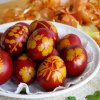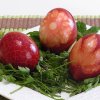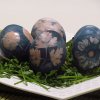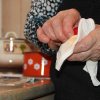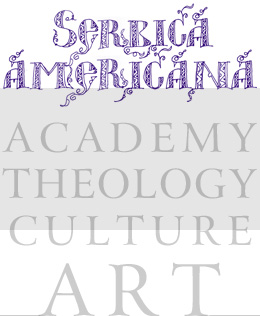"Pišanice" pronounced pee-SHAH-nee-tseh (or "pišanica" pee-SHAH-nee-tsah in singular), is a term used in Serbian for decorated Easter eggs, particularly within the context of Orthodox traditions. It derives from the Slavic root "pisati," meaning "to write" or "to decorate," and refers to eggs adorned with patterns, dyes, or designs—often using natural materials such as onion skins, cabbage leaves or wax-resist techniques.
What You Will Need
Gather a few basic items—most of which you might already have at home:
- Fresh eggs (white eggs show colors best, but brown works too)
- Yellow onion skins (the papery outer layers, about a large handful per dozen eggs)
- Red cabbage (a small head, chopped roughly)
- Botanicals: small leaves, flowers, or herbs like parsley, dill, or clover (fresh or dried)
- Old pantyhose, cheesecloth or rags torn into 1" strips (to wrap the eggs)
- Twine or rubber bands
- Water, vinegar, and a couple of pots
- A bit of patience and curiosity
There is no need to rush—this process unfolds slowly, like a good story.
Preparing the Eggs and Botanicals
Start with clean, room-temperature eggs to avoid cracking when they boil. While the eggs sit out, take a moment to collect your botanicals. In Serbia, this might traditionally include small wildflowers or herbs from the garden—think delicate parsley sprigs or tiny daisies. The idea is to press these against the egg to create a silhouette pattern as the dye sets.
Cut your pantyhose or cheesecloth into squares, big enough to wrap an egg. Place a leaf or flower flat against the egg, then gently wrap it in the fabric, securing it with twine or a rubber band. It does not have to be perfect—just snug enough to hold the botanical in place. This step is a nice one to do together, with everyone picking their favorite shapes from the pile.
Making the Natural Dyes
Natural dyes are wonderfully unpredictable, and that is part of their charm. Here is how to work with onion skins and red cabbage, two staples that yield rich, earthy tones.
Onion Skin Dye (Warm Reds and Oranges)
Peel the dry outer skins from yellow onions—about a dozen or so will do for a dozen eggs. Place them in a pot, cover with water (around 4 to 6 cups), and add a splash of vinegar (a couple of tablespoons) to help the color stick. Bring it to a simmer for about 20 to 30 minutes until the water turns a deep, rusty hue. The smell is warm and nostalgic, like a kitchen in early spring.Strain out the skins if you like, or leave them in for a more mottled effect—Serbian pišanice often embrace these organic imperfections. Add your wrapped eggs to the pot, making sure they are submerged. Simmer gently for 15 to 20 minutes, then let them cool in the liquid for deeper color. You will get shades from soft terracotta to a bold brick red, depending on how long they steep.
Red Cabbage Dye (Subtle Blues and Purples)
Chop half a head of red cabbage and toss it into a pot with 4 to 6 cups of water and a splash of vinegar. Simmer for 30 minutes until the water takes on a purplish tint. The magic happens later—red cabbage dye turns eggs a surprising blue as it interacts with the shell. Strain the liquid, then add your wrapped eggs and simmer for 15 to 20 minutes. Let them cool in the dye for a few hours (or overnight in the refrigerator) for the color to develop fully. The result is a gentle, unexpected blue, sometimes with hints of lavender.Unwrapping and Finishing
Once the eggs are cool, it is time to reveal the designs. Carefully unwrap the fabric and peel off the botanicals—there is a quiet thrill in seeing the pale silhouette against the dyed background. The contrast might be subtle with natural dyes, but that is part of their understated elegance. For a traditional Serbian touch, rub the eggs with a bit of oil or bacon fat to give them a soft sheen. This step connects back to old customs, adding a practical beauty to the finished eggs.
Tips for a Relaxed Experience
- Do not worry about perfection. Natural dyes vary with egg type, steeping time, and even water chemistry—each egg is unique.
- Set up a cozy workspace with a cup of tea or coffee. This is not a race.
- If you are new to this, test one or two eggs first to get a feel for the colors.
- Leftover dye? Use it to tint fabric or paper for another project.
This is a craft that encourages one to pause and contemplate the sacredness of the Paschal season. Whether one is dyeing eggs to honor the Resurrection of Christ on Pascha or engaging in this practice during a quiet afternoon of Holy Week, it is a meaningful way to root tradition in daily life. Share them with loved ones as a sign of communal faith, or place a few in the home as a reminder of the humble blessings bestowed through Christ’s victory over death.
The Čuvarkuća: Our Guardian Egg
In Serbia, it is a tradition to commence the dyeing of Easter eggs with one known as the čuvarkuća, (pronounced CHOO-vahr-KOO-cha) which translates to “guardian” in Serbian. For Orthodox families, this initial egg holds a sacred significance beyond the beauty of the pišanice described earlier. It serves as a powerful symbol of protection for the household, rooted deeply in our faith.The čuvarkuća is colored red to represent the sacrifice of Christ on the Cross and the eternal life granted through His Resurrection, celebrated at Pascha. Serbian Orthodox tradition holds that this red egg safeguards the family from adversity—be it illness, misfortune, or evil—throughout the year. Once dyed, it is not consumed or used in games; rather, it is preserved until the following Pascha, often placed in the prayer corner alongside an icon, such as that of Saint Sava or the Theotokos. There it remains, a quiet testament to God’s enduring presence in the home.
This practice unites Serbian Orthodox families with their heritage and the Church. By preparing the čuvarkuća, each person honors the faith of past generations while affirming the triumph of Christ’s Resurrection. It stands as a humble yet profound emblem, protecting the household until a new guardian egg is prepared the next year.
Fionn Zarubica

